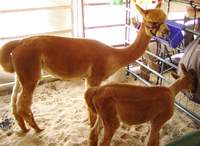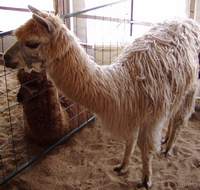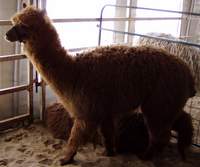|
Alpaca
|
It's such a luxurious fiber and just happens to come from one of the cutest animals ever!
Alpaca are a member of the Camelid family - in other words they are related to camels, llama, vicuna and guanaco. Originally from the Andes region of South America, Alpaca are domesticated and now live in many regions of the world.
Their fiber is stronger than wool and has a length of between 6" and 11", and yet it is incredibly soft. The coats consist of an outer layer of "guard hair", which is a little thicker, and the softer, finer fleece.
 The fleece is sheared once a year in late Spring/Early Summer. This allows the animals to use their own hair for warmth in the colder months, but the shearing makes them more comfortable during the warmer time of year.
The fleece is sheared once a year in late Spring/Early Summer. This allows the animals to use their own hair for warmth in the colder months, but the shearing makes them more comfortable during the warmer time of year.
These fine fleeces are called "blankets". At least that's what they call the longest fibers found on the animals backs and sides. This is the part of the fleece which is sent to mills to be spun into yarn.
The rest - the neck and leg fiber - is generally either discarded (sacrilege!), but more often now it is sold for felting purposes (and it still feels delightful).
Alpaca can be found in all shades from white through browns to black, and also some greys.
There are two kinds of alpaca - huacaya and suri. Huacaya look thick and cuddly with a densely packed fleece. They are shown in the photograph towards the top of this page.

Suri have very long curly locks and look more "shaggy". The suri alpaca fiber is generally used for suiting, as the fibers are longer, silkier and finer than its' counterpart the huacaya. I think both kinds look absolutely adorable!
Alpaca breeding is becoming quite popular as a small business, as they are relatively "low maintenance" animals. They are pretty much disease resistant, tend to make their mess in one place (easy clean up), and they say you can keep up to 8 animals on one acre.
Baby alpaca are called cria (pronounced cree-a), and the first shearing of a cria is classed as "baby alpaca" fiber. It is super-soft and mega-fine and I just want to snuggle up with it.
All in all, they are wonderful, curious and friendly animals that produce an amazingly gorgeous fiber. Seek out some raw fiber and try felting it by hand - it takes a little longer to felt than merino, but the results are just divine!
If you find alpaca yarn and it says "Hand Wash", then it will felt if you wash it by machine. Enjoy your sensory experience with this engaging fiber!





